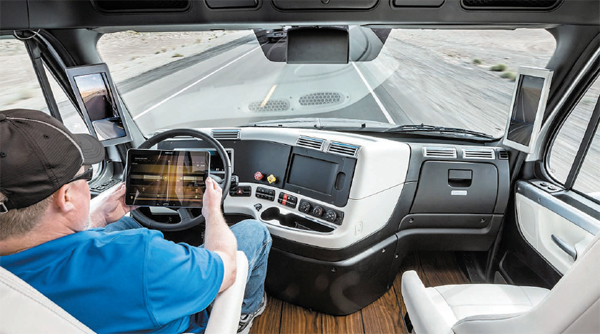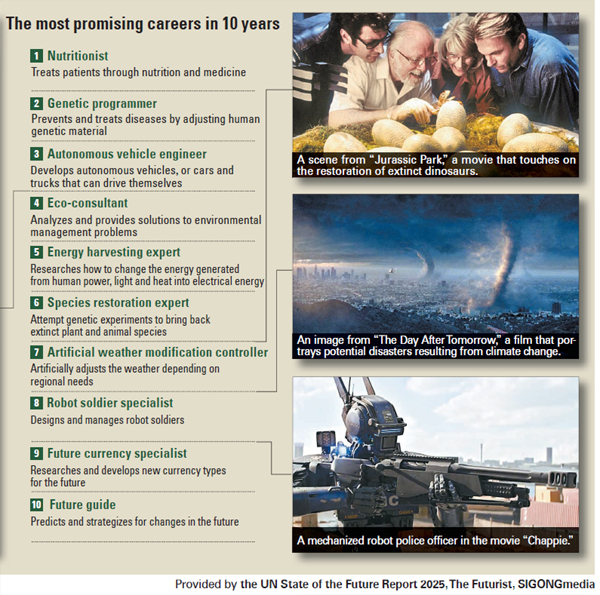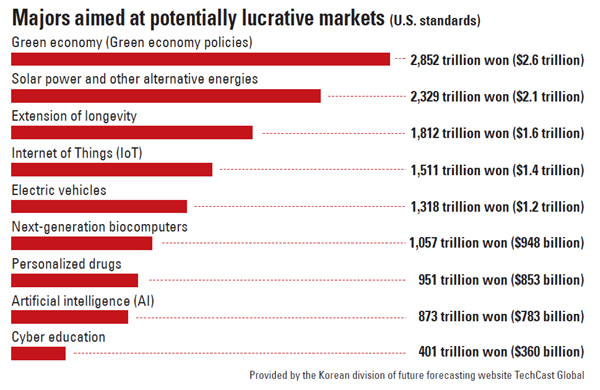Industry growth potential affects areas of study

German multinational automotive corporation Daimler AG received a license from the U.S. state of Nevada in May to test a hands-free, self-driving truck on the state’s highways. A driver can attend to other duties and must only take the steering wheel in case of emergencies. Futurologists believe that in 10 years, engineering for autonomous vehicles will be a promising career. Provided by Daimler AG
As the governmental began crafting more policies aimed at promoting the heavy chemicals business, more Koreans turned their studies toward the chemical engineering department at Seoul National University.
Then, as construction boomed in the Middle East in the 1970s, mechanical and architectural engineering joined chemical engineering as the most prominent fields of work and study.
The following decade, electrical engineering boomed in popularity, with electronics and electricity considered potential areas for growth.
College-bound students in the early ’90s flocked to computer science, but following the Asian financial crisis later in the decade, premed majors dominated due to its perceived job security - a phenomenon that illustrated the link between industry and the economy and the popularity of college majors.
Given society’s dynamic needs and widespread employment concerns amid a competitive job market, futurologists - those who hypothesize likely and desirable futures - recommend people think ahead about what the world will have and need to determine lucrative fields for careers in the future.
“In Australia, middle and high school students are, without fail, taught about how society will develop in the future during social studies class,” said Park Young-sook, a futurology professor in Ewha Womans University’s Graduate School of Design. “To address the problem of youth unemployment, the government must sort out promising fields of study.”
Parents contemplating their children’s futures are typically most eager to know what fields of study will produce jobs in the future; and looking at future studies forecasts, a considerable number of currently propitious fields can erelong lose their competitive edge.

“Already some U.S. universities have created longevity research teams, so parents and children should look ahead for developments in the future and consider [studying and working] in the field of life science.”
According to the Korean division of TechCast Global, a future technology forecasting website created by William E. Halal, a professor at George Washington University, a number of technologies devoted to increasing lifespans will be developed by 2039, and in the United States alone, that market will be worth 1,812 trillion won ($1.6 trillion).
Overall, futurologists believe, jobs will be created in the fields of medicine, energy and transportation.
According to forecasts by TechCast, there is a possibility that medicine custom-designed to address an individual’s health needs, from diabetes to high blood pressure, will expand into a field worth 3,423 trillion won by 2026.
As for the energy field, futurologists believe that as solar power becomes universally used, the market for alternative sources of energy will surge. The current market size for alternative energy in the United States is 2,329 trillion won.

“Just four years ago in the field of cloud computing, the size of the market was forecast to be extremely large, but as most [cloud] services were offered for free, it’s become more difficult to find an income structure,” said Park. “Futurologists believe that by 2025, biocomputers that go into a person’s body will emerge and mobile phones will disappear.”
However, if the IT field crosses with other areas like energy and medicine, it will consistently require a labor force, particularly in software development.
Fields like transportation that have been selected as job creators in the future are already beginning to produce jobs.
The U.S. state of Nevada recently granted a license to Daimler AG, a German multinational automotive corporation, to test its self-driving heavy freight truck. While a person is needed to drive the vehicle on roads in cities and the suburbs, the autonomous truck is licensed for hands-free use on highways.
The autonomous vehicle has a radar sensor and camera that allow it to avoid collisions, and features technology that prevents it from driving outside its lane.
“Five years from now, these trucks will be available for purchase,” said Wolfgang Bernhard, a Daimler AG board member responsible for trucks and buses. “The technology is already developed, but getting permission from each [state] government will take some time.”
The United Nations State of the Future Report 2025, which collected the opinions of 3,000 futurologists worldwide, determined that in 2011, autonomous automobile engineers would be a future profession.
Additionally, Professor Halal believes that by 2027, the worldwide market for electric vehicles will grow to 4,744 trillion won.
“As they grow up, children need to know where jobs will come from to develop skills in relevant fields and create their paths,” said Park Ki-seok, the representative director for SIGONGmedia, which offers online videos on jobs with future growth potential.
“Parents shouldn’t insist on any specific profession, but rather show [their children] a vision of the future.”
The Futurist, a bimonthly magazine published by futurologists, and the UN State of the Future Report 2025 anticipate that genetic engineers, tasked with changing human genetic material to prevent or lessen the risk of genetically inherited diseases; species restoration specialists who can restore extinct species; robot soldiers; and weather control specialists, who can artificially adjust the weather depending on regional needs, are among some of the jobs anticipated to be in demand the future.
BY KIM SUNG-TAK [enational@joongang.co.kr]










with the Korea JoongAng Daily
To write comments, please log in to one of the accounts.
Standards Board Policy (0/250자)